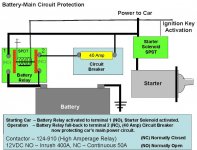RAC68
Darth Vader
Offline
Hi All,
I am back looking at installing a manually reset circuit breaker or fuse onto my battery and initially anticipated use of a 300 Amp 12VDC unit. A friend questioned the 300 Amp as too low and suggested I go higher amp unit. Since my amp meter does not register high enough to do an actual reading, I was wondering if anyone had an idea of what the starter max draw would be for a BJ8 using the original starter at a low of 30F with 20W50 oil.
Also, I was told that breakers or fuses could be put in series to increase amperage handling…a 300A+100A would support around 400Amps. I have just heard this and would also like to know if this is true.
I understand this is not a common thing to measure so I would appreciate any ideas.
Ray (64BJ8P1)
I am back looking at installing a manually reset circuit breaker or fuse onto my battery and initially anticipated use of a 300 Amp 12VDC unit. A friend questioned the 300 Amp as too low and suggested I go higher amp unit. Since my amp meter does not register high enough to do an actual reading, I was wondering if anyone had an idea of what the starter max draw would be for a BJ8 using the original starter at a low of 30F with 20W50 oil.
Also, I was told that breakers or fuses could be put in series to increase amperage handling…a 300A+100A would support around 400Amps. I have just heard this and would also like to know if this is true.
I understand this is not a common thing to measure so I would appreciate any ideas.
Ray (64BJ8P1)

 Hi Guest!
Hi Guest!

 smilie in place of the real @
smilie in place of the real @
 Pretty Please - add it to our Events forum(s) and add to the calendar! >>
Pretty Please - add it to our Events forum(s) and add to the calendar! >> 


